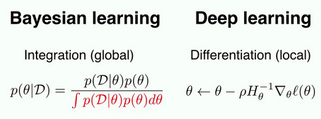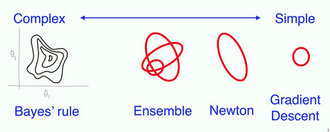Deep Learning With Bayesian Principles - Emtiyaz Khan
- link
- Mohammad Emtiyaz Khan | Deep Learning with Bayesian Principles · SlidesLive
- speaker
- Emtiyaz Khan
- tags
- Bayesian Deep Learning, NeurIPS
Goals
- To understand the fundamental principles of learning from data
- use them to develop learning algorithms
Deep learning assumes that the environment is stationary: e.g. all the information required to classify images is already available in large amounts, and these don’t change quickly over time.
Wish to design life-long learning systems: Bayesian learning has a natural update rule to update posterior beliefs given new data.
| Bayes | DL | |
|---|---|---|
| Can handle large data and complex models? | ❌ | ✔️ |
| Scalable training? | ❌ | ✔️ |
| Can estimate uncertainty? | ✔️ | ❌ |
| Can perform sequential/incremental learning? | ✔️ | ❌ |
We start with the Bayes rule, and derive many existing algorithms through various approximations.
Deep Learning
Frequentist: Empirical Risk Minimization (ERM) or Maximum Likelihood
\begin{equation} \mathrm{min}_{\theta} l(D, \theta) = \sum_{i=1}^{N} [y_i - f_{\theta}(x_i)^2]
- \gamma \theta^T \theta \end{equation}
Scales well to large data and complex models, good performance in practice. Does not tell you what the model does not know (uncertainty).
Bayesian Principles
- Sample \(\theta \sim p(\theta)\) : prior
- Score \(p (D| \theta) = \prod_{i=1}^{N} p(y_i | f_{\theta}(x_i))\) : likelihood
- Normalize:
\begin{equation} p(\theta | D) = \frac{p(D|\theta)p(\theta)}{\int p(D|\theta)p(\theta) d \theta} \end{equation}
This is a global method, integrating over all models, but does not scale to large problems. Global properties enable sequential update.

To scale Bayesian learning, we need to approximate the posterior distribution. Different posterior approximation methods lead to different learning rules.

Bayesian Learning Rule
- Deep learning rule: \(\min_{\theta} l(\theta)\)
- Bayesian learning rule: \(\min_{q \in Q} E_{q(\theta)} [l (\theta)] - H(q)\) where \(H(q)\) is entropy (regularization)
Bayesian learning rule optimizes over all distributions.
- Deep learning algo: \(\theta \leftarrow \theta-\rho H_{\theta}^{-1} \nabla_{\theta} \ell(\theta)\)
- Bayes learning rule: \(\lambda \leftarrow \lambda-\rho \nabla_{\mu}\left(\mathbb{E}_{q}[\ell(\theta)]-\mathcal{H}(q)\right)\)
- \(\lambda\) is the natural parameter, and \(\mu\) the expectation parameter of an exponential family distribution \(q\).
Deep learning algorithms are obtained by choosing an appropriate approximation \(q\), and giving away the global property of the rule.
Deriving Gradient Descent
Gradient descent is derived from using a Gaussian with fixed covariance, and approximating \(E_q[l(\theta)] \approx l(m)\).